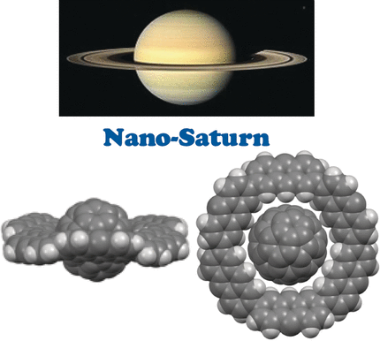|
NOVIDADES
Nano-Saturn systems with a spherical molecule and a macrocyclic ring have been a fascinating structural motif for researchers. The ring must have a rigid, circular form, and must hold the molecular sphere firmly in its midst. Fullerenes are ideal candidates for the nano-sphere. They are made of carbon atoms linked into a network of rings that form a hollow sphere. The most famous fullerene, C60, consists of 60 carbon atoms arranged into 5- and 6-membered rings like the leather patches of a classic soccer ball. The electrons in their double bonds, knows as the Pi-electrons, are in a kind of “electron cloud”, able to freely move about and have binding interactions with other molecules, such as a macrocycle that also has a “cloud” of Pi-electrons. The attractive interactions between the electron clouds allow fullerenes to lodge in the cavities of such macrocycles.  Nano-Saturn - Supramolecular complex formation: Anthracene macrocycle and C60 fullerene. © Wiley-VCH
Their success resulted from a different type of bonding between the “nano-planet” and its “nano-ring”. Instead of using the attraction between the Pi-electron clouds of the fullerene and macrocycle, the team working with Shinji Toyota used the weak attractive interactions between the π-electron cloud of the fullerene and non-Pi-electron of the carbon-hydrogen groups of the macrocycle. To construct their “Saturn ring”, the researchers chose to use anthracene units, molecules made of three aromatic six-membered carbon rings linked along their edges. They linked six of these units into a macrocycle whose cavity was the perfect size and shape for a C60 fullerene. Eighteen hydrogen atoms of the macrocycle project into the middle of the cavity. In total, their interactions with the fullerene are enough to give the complex enough stability, as shown by computer simulations. By using X-ray analysis and NMR spectroscopy, the team was able to prove experimentally that they had produced Saturn-shaped complexes. Science Daily. Posted: June 08, 2018. |
|||||||||||||||||||||||||